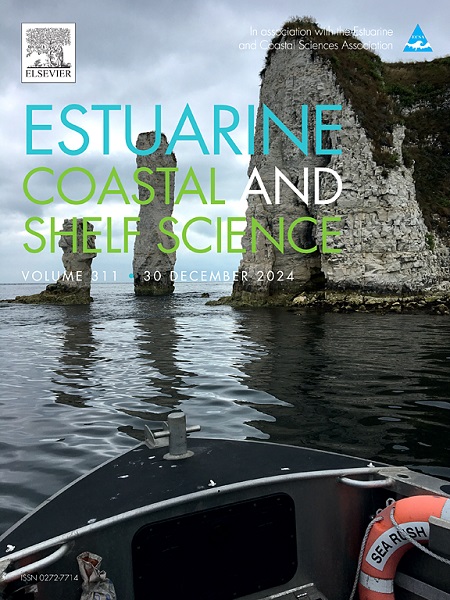法国海盆底栖生物群落的长期变化
IF 2.6
3区 地球科学
Q1 MARINE & FRESHWATER BIOLOGY
引用次数: 0
摘要
朗斯潮汐发电厂(RTPP)建设后生态变化的监测和量化在过去得到了广泛的讨论,并为我们提供了宝贵的恢复生态学知识储备。群落轨迹分析框架与常规方法相结合,对1976年、1995年、2010年和2020年取样的Rance盆地(Normano-Breton Gulf)软沉积物进行了分析、表征和表征。自1976年以来,在软底上共发现了483种。在流域尺度上,每项研究都有6个物种是最丰富的,这表明优势物种对流域群落结构的影响很大。在RTPP建设近50年后,底栖生物群落继续自我构建。在流域和局地尺度上研究了底栖生物群落的分类轨迹。生态轨迹主要是对沉积学变化的响应,呈现出上下游的时间变异性。物种丰度的局部变化也导致了在组合尺度上观察到的组成差异。在20世纪90年代底部的殖民放缓之后,物种数量在2020年经历了显着增加,这与海水的发展、沉积物的再分配、栖息地的异质性和海草的动态有关,这些都创造了复杂的栖息地结构。本文章由计算机程序翻译,如有差异,请以英文原文为准。

Long-term changes of benthic communities of the Rance maritime basin
The monitoring and quantification of ecological changes following the construction of the Rance Tidal Power Plant (RTPP) have been extensively discussed in the past and provide us with a valuable reservoir of knowledge on restoration ecology. The Community Trajectory Analysis Framework was used in conjunction with conventional methods to analyse, characterize, and represent long-term changes in soft sediments in the Rance basin (Normano-Breton Gulf) sampled in 1976, 1995, 2010 and 2020. A total of 483 species have been identified since 1976 on soft bottoms. At the basin scale, a group of six species were among the most abundant in each study, revealing a strong impact of dominant species on community structuring in the basin. Benthic assemblages continue to structure themselves nearly 50 years after the construction of the RTPP. The taxonomic trajectories of benthic assemblages were studied at both the basin and local scales. Mainly in response to sedimentological changes, ecological trajectories showed temporal variability upstream and downstream. Local variations in species abundances also contributed to differences in composition observed at the assemblage scale. After a slowdown in the colonization of bottoms in the ‘90s, the number of species experienced a significant increase in 2020, linked to the progression of marine waters, sediment redistribution, the habitat heterogeneity, and the dynamics of seagrass, which have created complex habitat architecture.
求助全文
通过发布文献求助,成功后即可免费获取论文全文。
去求助
来源期刊
CiteScore
5.60
自引率
7.10%
发文量
374
审稿时长
9 months
期刊介绍:
Estuarine, Coastal and Shelf Science is an international multidisciplinary journal devoted to the analysis of saline water phenomena ranging from the outer edge of the continental shelf to the upper limits of the tidal zone. The journal provides a unique forum, unifying the multidisciplinary approaches to the study of the oceanography of estuaries, coastal zones, and continental shelf seas. It features original research papers, review papers and short communications treating such disciplines as zoology, botany, geology, sedimentology, physical oceanography.

 求助内容:
求助内容: 应助结果提醒方式:
应助结果提醒方式:


